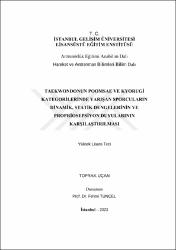Taekwondonun poomsae ve kyorugi kategorilerinde yarışan sporcuların dinamik, statik dengelerinin ve propriosepsiyon duyularının karşılaştırılması
Özet
Bu tezin amacı taekwondonun kyorugi ve poomsae kategorilerinde yarışan sporcuların denge duyularını ölçmek, denge türlerini saptamak, karşılaştırmak ve varsa aradaki farklılıkları tespit etmektir. Çalışma grubu İzmir iline bağlı Bayraklı Belediyesi Spor Kulübü ve Kimdooman Taekwondo Spor Kulübü bünyesinde ulusal ve uluslararası dereceleri bulunan toplam 28 sporcunun katılımıyla oluşturulmuştur. Araştırmada katılımcıların yaş boy ve kiloları tespit edilmiş, dinamik dengeyi ölçmek için Yıldız Denge Testi, statik dengeyi ölçmek için Flamingo Denge Testi Propriosepsiyon duyusunu ölçmek için BESS testi kullanılmıştır. Elde edilen veriler SPSS 28.0 istatistik programından faydalanılarak analiz edilmiştir. Verilerin analizinde, normal dağılım gösterip göstermediklerini belirlemek adına Shapiro-Wilk Testi uygulanmış olup verilerin normal dağılımı üzerine araştırmaya katılan katılımcıların demografik özellikleri için frekans analizi ve tanımlayıcı istatistikler hesaplanmıştır. Sonrasında poomsae ve kyorugi gruplarındaki katılımcıların Flamingo Denge Testi, Yıldız Denge Testi ve BESS testindeki skorları arasındaki farkın belirlenebilmesi amacıyla bağımsız örneklem ''t testi'' kullanılmıştır. Yapılan ölçümler ve istatistiksel analiz sonucunda taekwondonun poomsae kategorisinde ve kyorugi kategorilerinde yarışan sporcuların statik denge yetileri arasında anlamlı düzeyde farklılık bulunduğu, taekwondonun poomsae ve kyorugi kategorilerinde yarışan sporcuların dinamik denge yetileri arasında anlamlı düzeyde farklılık bulunmadığı, taekwondonun poomsae ve kyorugi kategorilerinde yarışan sporcuların propriosepsiyon duyuları arasında anlamlı düzeyde farklılık bulunduğu, ölçümler ve istatiksel analiz ile saptanmıştır. The aim of this thesis is to measure the balance sense of the athletes competing in the Kyorugi and Poomsae categories of Taekwondo, to determine the balance types, to compare them and to determine the differences, if any. The working group was formed within the body of Bayraklı Municipality Sports Club and Kimdooman Taekwondo Sports Club of İzmir province with the participation of 28 athletes with national and international degrees. In the study, participants' age, height and weight were determined, Star Balance Test was used to measure dynamic balance, Flamingo Balance Test to measure static balance, and BESS test was used to measure proprioception sense. The obtained data were analyzed using SPSS 28.0 statistical program. First, frequency analysis and descriptive statistics were calculated for the demographic characteristics of the participants participating in the study. Afterwards, two independent samples "t-test" was used to determine the difference between the scores of the participants in the Poomsae and Kyorugi groups in the Flamingo Balance Test, Star Balance Test and BESS test. As a result of the measurements and statistical analysis, it was determined by the measurements and statistical analysis that the static balances of the athletes competing in the poomsae category of taekwondo were significantly different from the athletes competing in the kyorugi category, there was no significant difference in the dynamic balances of the two categories, and the proprioception sense of the athletes competing in the poomsae category differed significantly.
Bağlantı
https://hdl.handle.net/11363/6365Koleksiyonlar
- Yüksek Lisans Tezleri [1219]
Aşağıdaki lisans dosyası bu öğe ile ilişkilidir:


















